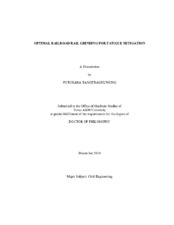| dc.contributor.advisor | Fry, Gary T. | |
| dc.creator | Tangtragulwong, Potchara | |
| dc.date.accessioned | 2012-02-14T22:18:50Z | |
| dc.date.accessioned | 2012-02-16T16:14:31Z | |
| dc.date.available | 2012-02-14T22:18:50Z | |
| dc.date.available | 2012-02-16T16:14:31Z | |
| dc.date.created | 2010-12 | |
| dc.date.issued | 2012-02-14 | |
| dc.date.submitted | December 2010 | |
| dc.identifier.uri | https://hdl.handle.net/1969.1/ETD-TAMU-2010-12-8909 | |
| dc.description.abstract | This dissertation aims to study the benefit of rail grinding on service life of railroad rails, focusing on failures due to rolling contact fatigue (RCF) at the rail head. Assuming a tangent rail with one-point contact at the running surface, a finite element analysis of a full-scale wheel-rail rolling contact with a nonlinear isotropic kinematic hardening material model is performed to simulate the accumulation of residual stresses and strains in the rail head. Using rolling stress and strain results from the sixth loading cycle, in which residual stresses and strains are at their steady-state, as input, two critical plane fatigue criteria are proposed for fatigue analyses. The first fatigue criterion is the stress-based approach—namely the Findley fatigue criterion. It suggests an important role of tensile residual stresses on subsurface crack nucleation and early growth in the rail head, but applications of the criterion to the near-running-surface region are limited because of plastic deformation from wheel-rail contact. The second fatigue criterion is the strain-based approach—namely the Fatemi-Socie fatigue criterion. Contributed mainly from shear strain amplitudes and factorized by normal stress components, the criterion also predicts fatigue crack nucleation at the subsurface as a possible failure mode as well as fatigue crack nucleation at the near-surface, while maintaining its validity in both regions. A collection of fatigue test data of various types of rail steel from literature is analyzed to determine a relationship between fatigue damages and number of cycles to failure. Considering a set of wheel loads with their corresponding number of rolling passage as a loading unit (LU), optimizations of grinding schedules with genetic algorithm (GA) show that fatigue life of rail increases by varying amount when compared against that from the no-grinding case. Results show that the proposed grinding schedules, optimized with the exploratory and local-search genetic algorithms, can increase fatigue life of rail by 240 percent. The optimization framework is designed to be able to determine a set of optimal grinding schedules for different types of rail steel and different contact configurations, i.e. two-point contact occurred when cornering. | en |
| dc.format.mimetype | application/pdf | |
| dc.language.iso | en_US | |
| dc.subject | Rolling contact fatigue | en |
| dc.subject | Wheel-rail contact | en |
| dc.subject | Critical-plane fatigue criterion | en |
| dc.subject | Stress-based fatigue criterion | en |
| dc.subject | Strain-based fatigue criterion | en |
| dc.subject | Genetic algorithm | en |
| dc.subject | Railroad rail grinding | en |
| dc.subject | Fatigue crack nucleation | en |
| dc.subject | Rail grinding optimization | en |
| dc.title | Optimal Railroad Rail Grinding for Fatigue Mitigation | en |
| dc.type | Thesis | en |
| thesis.degree.department | Civil Engineering | en |
| thesis.degree.discipline | Civil Engineering | en |
| thesis.degree.grantor | Texas A&M University | en |
| thesis.degree.name | Doctor of Philosophy | en |
| thesis.degree.level | Doctoral | en |
| dc.contributor.committeeMember | Jones, Harry L. | |
| dc.contributor.committeeMember | Hurlebaus, Stefan | |
| dc.contributor.committeeMember | Creasy, Terry S. | |
| dc.type.genre | thesis | en |
| dc.type.material | text | en |


